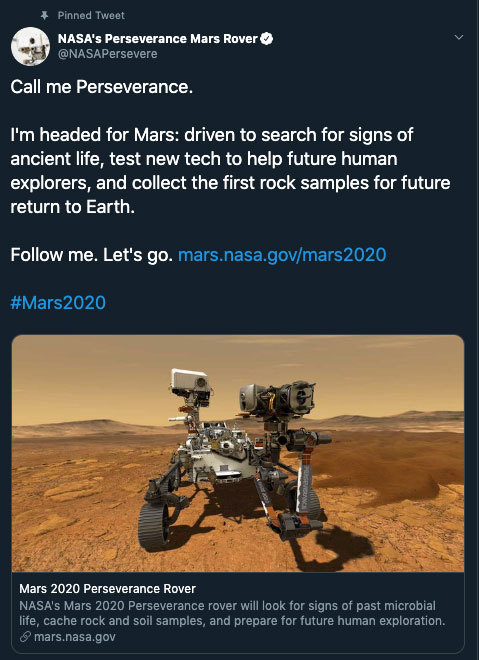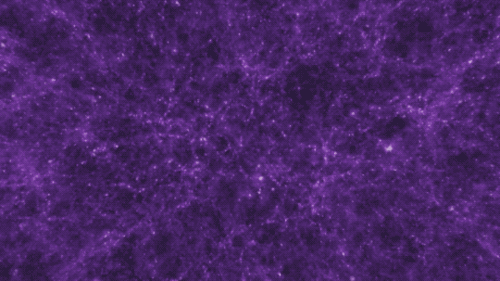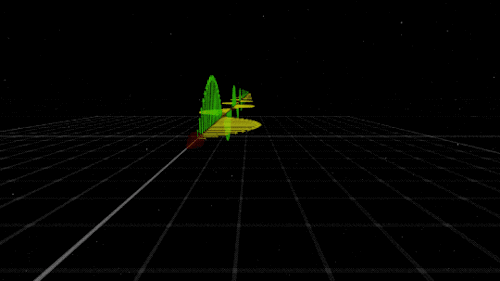Lv.20 / he/they INTP/INFP Space Enthusiast --Don't follow me or interact if you have an inappropriate blog / my talking is tagged Cyberpiko speaks
114 posts
Latest Posts by cybernetics-cyberspace - Page 4






R. I. P. oppy!! we love you so much






R. I. P. oppy!! we love you so much

Allow us to reintroduce someone … the name’s Perseverance.
With this new name, our Mars 2020 rover has now come to life! Chosen by middle school student Alex Mather, Perseverance helps to remind ourselves that no matter what obstacles we face, whether it’s on the way to reaching our goals or on the way to Mars, we will push through. In Alex’s own words,
“We are a species of explorers, and we will meet many setbacks on the way to Mars. However, we can persevere. We, not as a nation but as humans, will not give up. The human race will always persevere into the future.”
Welcome to the family. ❤️
Make sure to follow us on Tumblr for your regular dose of space: http://nasa.tumblr.com.







sorry not sorry (credits to @arianwen44 for the artwork)
adhd culture is writing fast but having your mind go even faster so you accidentally a few words
“My battery is low and it is getting dark” is the Mars Rover version of “I don’t feel so good, Mr. Stark.”
I’m emotionally compromised by both.
“My battery is low and it is getting dark” is the Mars Rover version of “I don’t feel so good, Mr. Stark.”
I’m emotionally compromised by both.








The Science Has Spoken: Pluto Will Never Be A Planet Again
“What’s perhaps most remarkable is that we can make a simple, mathematical relationship between a world’s mass and its orbital distance that can be scaled and applied to any star. If you’re above these lines, you’re a planet; if you’re below it, you’re not. Note that even the most massive dwarf planets would have to be closer to the Sun than Mercury is to reach planetary status. Note by how fantastically much each of our eight planets meets these criteria… and by how much all others miss it. And note that if you replaced the Earth with the Moon, it would barely make it as a planet.”
It was a harsh lesson in astronomy for all of us in 2006, when the International Astronomical Union released their official definition of a planet. While the innermost eight planets made the cut, Pluto did not. But given the discovery of large numbers of worlds in the Kuiper belt and beyond our Solar System, it became clear that we needed something even more than what the IAU gave us. We needed a way to look at any orbiting worlds around any star and determine whether they met a set of objective criteria for reaching planetary status. Recently, Alan Stern spoke up and introduced a geophysical definition of a planet, which would admit more than 100 members in our Solar System alone. But how does this stand up to what astronomers need to know?
As it turns out, not very well. But the IAU definition needs improving, too, and modern science is more than up to the challenge. See who does and doesn’t make the cut into true planetary status, and whether Planet Nine – if real – will make it, too!
hello dark mode users :)
. . ✦ ˚ . ✦ . . ゚ . • . , . . ✦ . • ✦ • ˚ . ☄ . . . • ✦ . . . . . . . ゚ . ✦ , . . ✦ . . ☀️ • . . . . • . . . .
✦ . ✦ . ✦ . • .
• . . 🌏 . . ✦ . • ✦ • ˚ . ☄ . . . . • . . ✦ . . . . . . . . . ゚ .
. . . . . . . . . ✦ . • ✦ • ˚ . . ☄ . • . . . . . • . . • ✦ . . 🪐 . . . . . ゚ . ✦ , . . . ✦ . • ✦ . 🌘 . . . . . . ゚ . ✦ , . . ✦ ✦ . • ✦ • ˚ . . ☄ . • . . . . . . ✦ ✦ . •
🔭
May the Four Forces Be With You!
May the force be with you? Much to learn you still have, padawan. In our universe it would be more appropriate to say, “May the four forces be with you.”

There are four fundamental forces that bind our universe and its building blocks together. Two of them are easy to spot — gravity keeps your feet on the ground while electromagnetism keeps your devices running. The other two are a little harder to see directly in everyday life, but without them, our universe would look a lot different!
Let’s explore these forces in a little more detail.
Gravity: Bringing the universe together

If you jump up, gravity brings you back down to Earth. It also keeps the solar system together … and our galaxy, and our local group of galaxies and our supercluster of galaxies.
Gravity pulls everything together. Everything, from the bright centers of the universe to the planets farthest from them. In fact, you (yes, you!) even exert a gravitational force on a galaxy far, far away. A tiny gravitational force, but a force nonetheless.

Credit: NASA and the Advanced Visualization Laboratory at the National Center for Supercomputing and B. O'Shea, M. Norman
Despite its well-known reputation, gravity is actually the weakest of the four forces. Its strength increases with the mass of the two objects involved. And its range is infinite, but the strength drops off as the square of the distance. If you and a friend measured your gravitational tug on each other and then doubled the distance between you, your new gravitational attraction would just be a quarter of what it was. So, you have to be really close together, or really big, or both, to exert a lot of gravity.
Even so, because its range is infinite, gravity is responsible for the formation of the largest structures in our universe! Planetary systems, galaxies and clusters of galaxies all formed because gravity brought them together.
Gravity truly surrounds us and binds us together.
Electromagnetism: Lighting the way

You know that shock you get on a dry day after shuffling across the carpet? The electricity that powers your television? The light that illuminates your room on a dark night? Those are all the work of electromagnetism. As the name implies, electromagnetism is the force that includes both electricity and magnetism.
Electromagnetism keeps electrons orbiting the nucleus at the center of atoms and allows chemical compounds to form (you know, the stuff that makes up us and everything around us). Electromagnetic waves are also known as light. Once started, an electromagnetic wave will travel at the speed of light until it interacts with something (like your eye) — so it will be there to light up the dark places.

Like gravity, electromagnetism works at infinite distances. And, also like gravity, the electromagnetic force between two objects falls as the square of their distance. However, unlike gravity, electromagnetism doesn’t just attract. Whether it attracts or repels depends on the electric charge of the objects involved. Two negative charges or two positive charges repel each other; one of each, and they attract each other. Plus. Minus. A balance.
This is what happens with common household magnets. If you hold them with the same “poles” together, they resist each other. On the other hand, if you hold a magnet with opposite poles together — snap! — they’ll attract each other.
Electromagnetism might just explain the relationship between a certain scruffy-looking nerf-herder and a princess.
Strong Force: Building the building blocks

Credit: Lawrence Livermore National Laboratory
The strong force is where things get really small. So small, that you can’t see it at work directly. But don’t let your eyes deceive you. Despite acting only on short distances, the strong force holds together the building blocks of the atoms, which are, in turn, the building blocks of everything we see around us.
Like gravity, the strong force always attracts, but that’s really where their similarities end. As the name implies, the force is strong with the strong force. It is the strongest of the four forces. It brings together protons and neutrons to form the nucleus of atoms — it has to be stronger than electromagnetism to do it, since all those protons are positively charged. But not only that, the strong force holds together the quarks — even tinier particles — to form those very protons and neutrons.
However, the strong force only works on very, very, very small distances. How small? About the scale of a medium-sized atom’s nucleus. For those of you who like the numbers, that’s about 10-15 meters, or 0.000000000000001 meters. That’s about a hundred billion times smaller than the width of a human hair! Whew.
Its tiny scale is why you don’t directly see the strong force in your day-to-day life. Judge a force by its physical size, do you?
Weak Force: Keeping us in sunshine

If you thought it was hard to see the strong force, the weak force works on even smaller scales — 1,000 times smaller. But it, too, is extremely important for life as we know it. In fact, the weak force plays a key role in keeping our Sun shining.
But what does the weak force do? Well … that requires getting a little into the weeds of particle physics. Here goes nothing! We mentioned quarks earlier — these are tiny particles that, among other things, make up protons and neutrons. There are six types of quarks, but the two that make up protons and neutrons are called up and down quarks. The weak force changes one quark type into another. This causes neutrons to decay into protons (or the other way around) while releasing electrons and ghostly particles called neutrinos.
So for example, the weak force can turn a down quark in a neutron into an up quark, which will turn that neutron into a proton. If that neutron is in an atom’s nucleus, the electric charge of the nucleus changes. That tiny change turns the atom into a different element! Such reactions are happening all the time in our Sun, giving it the energy to shine.
The weak force might just help to keep you in the (sun)light.

All four of these forces run strong in the universe. They flow between all things and keep our universe in balance. Without them, we’d be doomed. But these forces will be with you. Always.
You can learn more about gravity from NASA’s Space Place and follow NASAUniverse on Twitter or Facebook to learn about some of the cool cosmic objects we study with light.
Make sure to follow us on Tumblr for your regular dose of space: http://nasa.tumblr.com

Feel free 🌻❤️ Bologna | 30/06/2019
I'm using google translate actually
Ciao, posso parlare con voi?
Aggiornamenti su come applichiamo le nostre Linee guida della community ai contenuti che incitano all’odio
Nell'agosto 2018 abbiamo apportato aggiornamenti su come abbiamo applicato le nostre Linee guida ai discorsi di incitamento all'odio e altri argomenti. A quel tempo era evidente che i social media e gli strumenti di pubblicazione creati per aiutare le persone a rimanere in contatto, venissero utilizzati da gruppi di odio - in particolare nazisti e altri suprematisti bianchi - per diffondere retorica dannosa alimentando azioni dannose. Tumblr non ha fatto eccezione. La nostra moderazione sull'incitamento all'odio non era dove doveva essere, quindi ci siamo impegnati a rimuovere questi contenuti dalla piattaforma in base alle vostre segnalazioni.
Vi abbiamo anche promesso in quel post che: “Continueremo a rivedere e modificare le nostre Linee guida per assicurarci che rispecchino accuratamente la nostra community e i suoi valori”.
Mantenere la nostra promessa
Da allora, abbiamo ascoltato i vostri feedback e rivalutato i nostri processi in modo da poter rimuovere in modo più efficace i contenuti di odio da Tumblr. Abbiamo scoperto che gran parte dei discorsi che incitano all'odio derivava da blog che sono già stati chiusi. Sebbene i loro post venissero eliminati con la chiusura del blog, i contenuti di questi post continuavano a comparire nei reblog. Inizialmente credevamo che la maggior parte dei reblog fosse fatta da persone che si oppongono all'odio o facilitano importanti discussioni anti-odio. Dopo aver esaminato molte delle vostre segnalazioni, abbiamo capito che sfortunatamente non è sempre stato così, quindi stiamo cambiando il modo in cui gestiamo questi reblog.
Abbiamo rivisto le vecchie segnalazioni e identificato quasi un migliaio di blog che erano stati sospesi per aver palesemente violato le nostre politiche contro i discorsi di odio, la maggior parte dei quali relativi al nazismo. Ancora una volta, anche se questi blog erano sospesi, il contenuto dei loro post talvolta sopravviveva nei reblog. A partire da questa settimana, inizieremo il processo di rimozione di tutti i reblog derivanti dai post originali sui blog precedentemente sospesi, ovvero circa 4,47 milioni di reblog. A causa del volume dei reblog, questi post devono essere rimossi a ondate. Ci aspettiamo di finire tra un paio di settimane.
Successivamente, valuteremo tutti i blog sospesi per incitamento all'odio e li prenderemo in considerazione per l'eliminazione di reblog di massa.
Non faremmo un cambiamento del genere senza considerare l'impatto sulla libertà di parola. La nostra intenzione originale rimane immutata: non vogliamo mettere a tacere coloro che stanno fornendo argomenti educativi, necessari e opposti all'incitamento all'odio. Abbiamo esaminato il nostro approccio con una varietà di gruppi esterni ed esperti per essere sicuri di allinearci con le loro linee guida consigliate.
Non esiste una soluzione infallibile, intelligenza artificiale o algoritmo in grado di colpire perfettamente il discorso dell'odio. Ecco perché abbiamo un team di Trust & Safety dedicato e un modo semplice per permettervi di segnalare qualsiasi incitazione all'odio che vedete.
Se vedi qualcosa su Tumblr che viola le nostre Linee guida della community, ti preghiamo di segnalarlo al nostro team di Trust & Safety per la revisione.
Da ultimo…
Siamo e resteremo sempre fedeli alla libertà di parola. Tumblr è un posto dove puoi essere te stesso ed esprimere le tue opinioni. L’incitazione all'odio non porta a questo. Quando l’incitazione all'odio non viene controllata, mette a tacere le voci che aggiungono gentilezza e valore alla nostra società. Questo non è il tipo di Tumblr che ognuno di noi desidera.
Per favore, continuate ad aiutarci a rendere Tumblr il posto che volete che sia. <3











